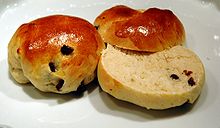Boller (baked goods)
Boller (the Bolle, the Boller) are yeast pastries widespread in Norway . The word Bolle is based on the old Norwegian word bolli ( related to ball) and refers to the mostly round shape of the baked goods. As a rule, they are sweet pastries, although there are also savory versions. It is important to emphasize that the Norwegian term Boller is not the same as German rolls. Bread rolls are called rundstykker in Norwegian . Traditionally, Boller served as dessert or coffee and on ceremonial occasions. Nowadays, bollers are consumed at any time of the day, both in everyday life and on special occasions.
sorts
There are different types of Boller , but all of them are based on a common basic recipe. Preparation can vary by family and region, but ingredients like flour, sugar, butter, eggs, yeast, and cardamom are almost always included. Common varieties are Solbolle , Lussekatt , Skolebolle , Skillingsbolle , Kanelbolle , Hvetebolle , Fastelavnsbolle , Rosinbolle and Sjokoladebolle .
Tradition and history
Many Boller varieties originally had a connection to the carnival season. There is therefore the thesis that the pastry comes from the Catholic tradition. The Fastelavnsbolle , derived from the German word Fastenabend , is only offered today at Mardi Gras or Carnival time . On Shrove Tuesday, shortly before Lent, it was time to indulge in food again and the sweet, nutritious yeast boll was seen as fitting. In the beginning, the Fastelavnsbolle was reserved for wealthier people in the cities, but it wasn't until the beginning of the 20th century that it became known to the rest of the population.
The other Boller varieties, such as the Berlinerbolle, also known as Berlin pancakes , are now baked goods that are offered all year round.
The Skillingsbolle is best known in Bergen , Norway's second largest city. However, the Skillingsbolle is not a traditional Norwegian pastry, but has its origin in Bergen's connection to the Hanseatic League . The cinnamon, which is an important ingredient in the Skillingsbolle, was imported by the Hanseatic people. It is unclear whether the combination of cinnamon, sugar and yeast dough was tried on the continent or only in mountains. The name Skillingsbolle is due to the tradition of naming baked goods after their prices - originally the baked goods cost one shilling .
Bollers are also common in other Scandinavian countries . October 4th is known as Kanelbolle Day in Sweden .
Boller in the language
In the Norwegian language, the word bolle not only denotes yeast pastries, but can also be used in other contexts. Bolle generally means something round. Therefore it can also refer to other dishes, such as Fiskeboller (fish dumplings), Raspeboller (potato and meat dumplings) and Kjøttboller (meat dumplings).
In addition, one encounters the term Boller in a figurative sense in some idioms . So there is the common expression in Norwegian Ta deg en bolle 'take a boll' , which means something like 'calm down' or 'calm down'. In Norway, cheekbones such. B. in small children, often referred to as "bollekinn" ( "chin" means "cheek").
The term “andre boller” is sometimes used to indicate change. According to the Norwegian Language Council's statement means norwegian nå blir det andre boller , now there are other Boller ' , that such. B. turns something bad for better - or vice versa.
The Norwegian phrase å ha en bolle i ovnen 'have a boll in the oven' is used more or less jokingly in colloquial language to describe pregnancy: you have something “unfinished” in your stomach that has yet to be “baked” . This phrase can also be found in the dictionary.
Web links
Individual evidence
- ↑ Bokmålsordboka. In: ordbok.uib.no. Retrieved February 6, 2019 (Norwegian).
- ↑ Line Kristiansen: Fastelavnsboller - Fakta & livsstil. In: forlagsliv.no. February 28, 2014, accessed February 6, 2019 (Norwegian).
- ↑ Ingvild Fjelltveit: Histories om skillingsbollen. In: abcnyheter.no. July 4, 2014, accessed February 6, 2019 (Norwegian).
- ↑ Elisabeth Dalseg: Skillingsboller, kanelboller, kanelsnurrer and kanelforbud: - Ta deg en bolle! - Dagbladet. In: dagbladet.no. October 4, 2016, Retrieved February 6, 2019 (Norwegian).
- ↑ Språkgodt. In: sprakradet.no. January 5, 2011, accessed February 6, 2019 (Norwegian).
- ↑ ha en bolle i ovnen - Norwegian Bokmål-English dictionary. In: glosbe.com. Retrieved February 6, 2019 .
